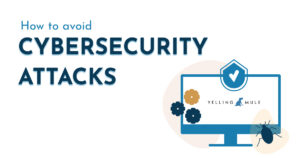Cybersecurity Risks
This month, Caesar Entertainment and MGM suffered major cybersecurity attacks that detrimentally impacted their businesses. Both casino giants lost control of their computer systems, gaming machines, elevators, ATMs, and hotel technology. The cybercriminal group, Scattered Spider, has been attributed as the culprit of the attacks having stolen more than six terabytes of data. A ransom was set for the data and Caesar Entertainment has reported paying $15 million for their sensitive information.
These major organizations fell victim to cyber-attacks, which proves that website security is vital for all businesses- big and small. Everyone is at risk. In this post, we are breaking down the different forms of cybersecurity attacks and how you can protect your site.
What are Malware Attacks?
In 2022, 5.5 billion websites were attacked by malware. Malware is malicious software that is installed without the user’s consent and used to steal data, gain unauthorized access, or disrupt a company’s operations.
One of the most common malware attacks is phishing. According to Forbes, “in 2022, there were 300,497 phishing victims with a total loss of $52,089,159 in the U.S. alone.” It is easy to fall victim to this type of attack. You could unknowingly install hidden malware from something as simple as clicking an attachment or link in an email. Once installed, hackers can steal private information, take control of your website, and/ or replace it entirely or link it to other content. Sometimes they utilize your email to send SPAM and your email address may later be blocked or sent directly into customer’s junk folders.
Another example of a phishing message is receiving an urgent email that says “fraudulent activity detected on your account” coming from what looks to be a trusted source (school, employer, etc.). Scammers get you to click in fast because they’re playing into your fears and are rushing to address the “problem”. It’s important to verify that the sender is actually who it initially claims to be before clicking into attachments, which will then install the malware in your computer without your knowledge.
If you don’t have a system in place to protect and update your WordPress site’s plugins, you are putting that website at risk for attack.
Recovering Data After Theft
Recovering data after a cybersecurity attack can be an expensive process. This year, $4.45 million is the average cost spent after a data breach, which is a 15% increase over the last 3 years. The slower the response time to a data breach, the more costly and problematic it can be for companies. IBM shares that it can take up to 69 days to contain a leak of data from a cyber attack.
That is why it is important to focus on preventative steps. Avoiding these worst-case scenarios can save you and your company a lot of time and money. Here are five helpful ways you can protect yourself moving forward:
- Be wary of suspicious emails
- Download carefully
- Improve passwords
- Update your cybersecurity with Yelling Mule
- Develop a Breach Response Plan
Also, it is important to remember you are not alone. There are a lot of helpful resources available that can help protect you from cybersecurity attacks. Through our Maintenance Services, we offer continual website support including, malware protection/removal, backups, firewalls to whitelist/blacklist traffic, and any plugin updates required due to vulnerabilities, new versions, and WordPress core updates.
For additional cybersecurity information please visit Mule Force or contact us to learn more about our maintenance services.


